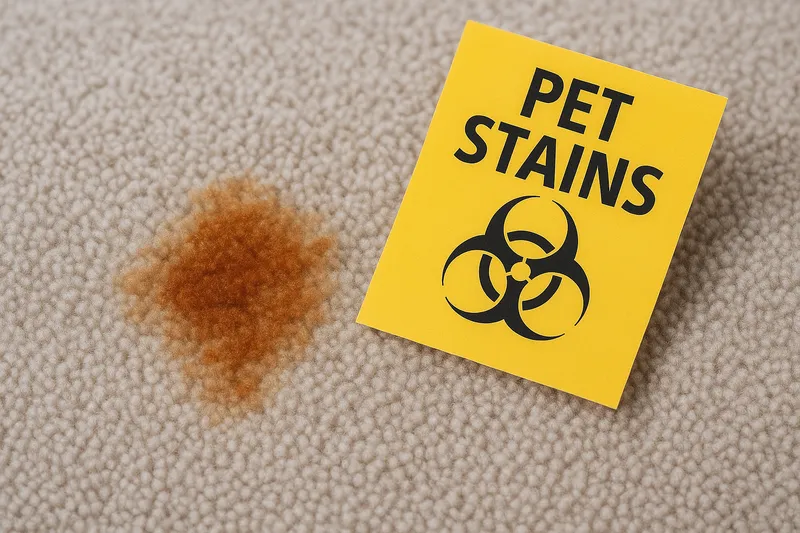
How to Remove Pet Stains Like a Pro

How to Remove Pet Stains Like a Pro
Introduction: When Accidents Happen (And They Will if Not YET)
Whether you're a dog lover, a cat cuddler, or live with an energetic new puppy, pet stains are inevitable. But here's the good news: they don't have to ruin your carpets, sofas, or your sanity. With the right approach, you can treat and remove even the worst pet stains like a seasoned professional.
In this expert guide, we’ll walk you through exactly how to tackle pet stains on carpets, rugs, and upholstery, step-by-step — with real pro tips, tricks, and industry techniques that actually work.
Understand the Enemy — Types of Pet Stains
Not all stains are created equal. To clean them properly, you need to know what you're dealing with:
Fresh Urine Stains — easiest to remove when treated quickly
Old Urine Stains — often require enzyme treatments and deodorising
Vomit — contains acid, may cause discolouration
Wet Mud from Paws — typically surface dirt but embeds quickly
Knowing what you’re up against helps you choose the right solution.

Tools & Products You’ll Need
Before you start, assemble your pet-stain-fighting toolkit:
White absorbent cloths or paper towels
Spray bottle
Enzyme-based cleaner (pet-specific)
Neutral pH carpet shampoo (optional)
Wet/dry vacuum or carpet extractor
Rubber gloves
Baking soda (odour control)
White vinegar (DIY option)
Pro Tip: Avoid products with bleach or harsh chemicals — they can damage fibres and lock in the stain.
Step-by-Step — Fresh Urine on Carpet
1. Blot — Don’t Rub:
Immediately blot the area with paper towels. Press firmly to absorb as much liquid as possible.
2. Apply Enzyme Cleaner:
Spray the affected area generously. Enzyme cleaners break down uric acid and odour-causing bacteria.
3. Let It Soak:
Give the product 5–10 minutes (or follow the label). The enzymes need time to work.
4. Blot Again:
Blot up the cleaner with a fresh cloth. Don’t oversaturate.
5. Rinse with Water:
Lightly rinse the area with clean water and blot again.
6. Dry & Deodorise:
Sprinkle baking soda when dry to neutralise any remaining smells. Vacuum it up after 30 minutes.

Dealing with Set-In or Dried Stains
Old stains are stubborn, but not hopeless. Here’s what to do:
Rehydrate the stain with warm (not hot) water.
Apply enzyme cleaner and gently agitate with a soft brush.
Let it sit longer — 15 to 30 minutes.
Extract using a wet/dry vacuum if available.
Repeat if needed, and always allow full drying.
Pro Trick: Enzyme cleaners can be re-applied in multiple layers — each time they’ll break down more of the organic material.
Vomit & Feces on Carpets or Sofas
Remove solids carefully using gloves and a blunt scraper
Clean residue with mild detergent or enzyme cleaner
Disinfect the area with pet-safe antimicrobial spray
Use a wet extractor to pull out moisture
Caution: Vomit can cause colour loss on natural fibres. Test before using vinegar or any acid-based solution.
DIY Pet Stain Remover Recipe (For Emergencies)
If you don’t have a pro product on hand:
DIY Solution:
1 cup white vinegar
1 cup warm water
2 tsp baking soda (mix in bottle after shaking)
Spray it generously, let it sit 5–10 mins, then blot. Works great for fresh stains.

Odour Control — Getting Rid of That "Pet Smell"
Sometimes the stain is gone but the smell lingers. Try this:
Use enzymatic odour neutralisers — not just air fresheners
Clean the underlay if urine soaked through the carpet
Deodorise with baking soda overnight
Steam clean the area if needed
Pro Tip: UV light can help you identify invisible urine stains to treat them properly.
When to Call the Pros
DIY is great — until it isn’t. Call a professional if:
The smell persists after multiple cleanings
Your carpet is discoloured
You suspect damage to underlay or padding
You’re dealing with repeated pet accidents (possible health issue)
Professional cleaners use high-heat extraction, fibre-safe enzymes, and industrial deodorisers that go far deeper than home kits.
Preventing Future Accidents
Train pets with positive reinforcement
Use puppy pads or litter trays in key zones
Clean accidents thoroughly — residual smells encourage repeat marking
Consider pet-friendly area rugs or sofa covers
Bonus Hack: Spray areas with citrus-based deterrent sprays — most pets dislike the smell.
Conclusion: Clean Floors, Happy Pets, Peace of Mind
Pet stains are frustrating — but with the right approach, you can remove them completely and protect your home. Stay calm, act quickly, use enzyme products, and don’t hesitate to call in professionals if needed.
Keep this guide handy, bookmark it, and remember: it’s not the stain — it’s how you treat it.
Want help from a professional? Get a free quote from eXteam Cleaning — trusted by hundreds of pet-loving homeowners across West Sussex.
